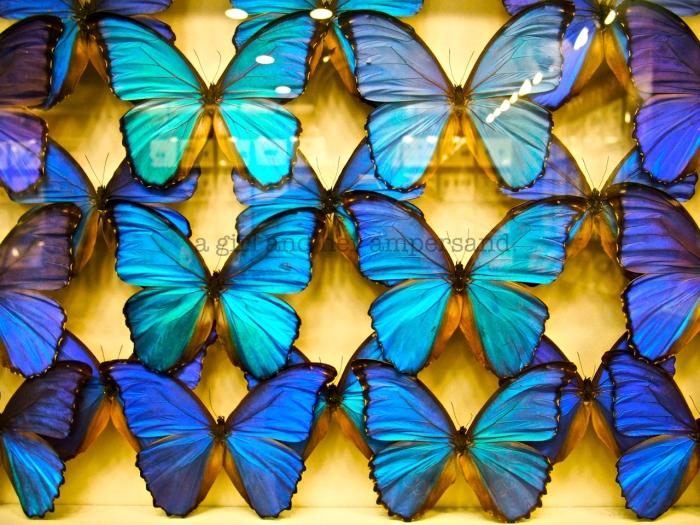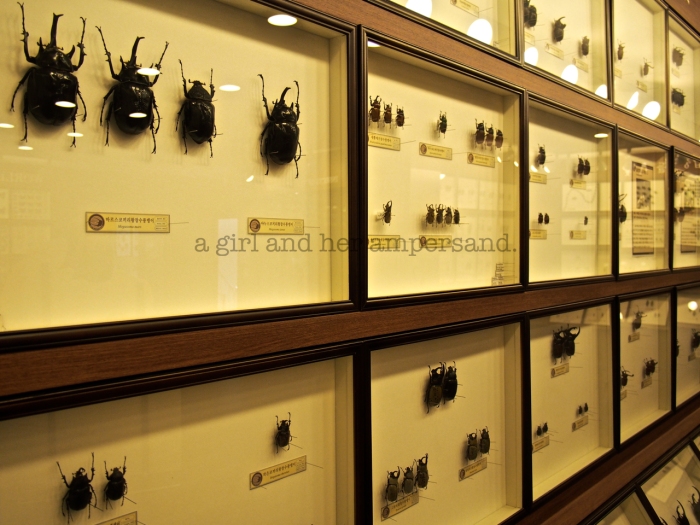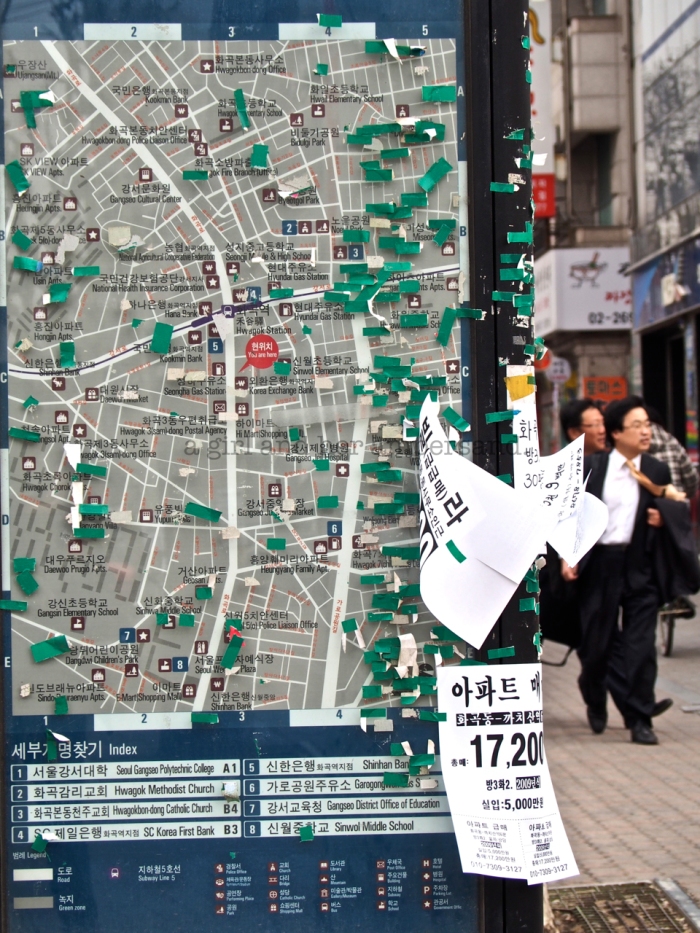Almost immediately, Hwagok produced one of the most unique, most unusual, and, least kid sister-friendly businesses we’ve turned up in the course of this project. About a block and a half down Gangseo-ro (강서로) from Exit 5 was 곤충박물관 충우 (Insect Museum Chung-u), easily spotted by the sign outside with pictures of several different butterflies and stag beetles enlarged to the size of a rather large terrier. Once I got past the initial B-movie shock, the creatures actually started to seem quite beautiful. Blown up to this magnitude their elaborate features and brilliant colors became more easily visible, and they made me think of what you might get if you put a bunch of Japanese shoguns in a gay pride parade.

 In the windows next to the photographs were several dozen insect specimens pinned and mounted in glass frames, including about 20 Morpho godarti butterflies a shade of blue that made them look as if a live current was running through them. Along with the butterflies there were also stag beetles, tarantulas, and three scorpions.
In the windows next to the photographs were several dozen insect specimens pinned and mounted in glass frames, including about 20 Morpho godarti butterflies a shade of blue that made them look as if a live current was running through them. Along with the butterflies there were also stag beetles, tarantulas, and three scorpions.
Chung-u isn’t just an insect museum, though. As its sign outside says, it’s also an insect shop selling insect goods, and lest you be tempted to think there’s no market for that sort of thing, Chung-u has been in business since 1996. When I stepped inside, my first impression was of how remarkably clean the place was; not exactly what I’d expected at a bug business. The two staffers working there were bent over a foam board, carefully pinning two large butterflies the color of autumn leaves in place. In the glass counter between them were dozens and dozens of dead specimens for sale, each carefully wrapped in a small packet with a price sticker attached to it. Stag beetles averaged between 8 and 15-thousand won, while the most expensive rhino beetle will set you back a cool 117,000. Behind the counter were shelves of neatly arranged plastic bins of more packeted insects, each bin labeled with the species’ Latin name and a large picture. If living things are more your bag, the store’s opposite wall had several aquariums that held beetles, tarantulas, and scorpions, and a refrigerator was stocked with food for stag beetle larva, which looks sort of like bleached couscous. Naturally, they also sell toys and t-shirts.
I stepped through a door in the back of the shop and headed up to the museum on the second and third floors. The second floor had dozens of varieties of butterflies, some with wings that looked like holograms, and several dozen varieties of stag and rhinoceros beetles from all over the world, including specimens from Australia, Colombia, Arizona, and Cameroon. They ranged in size, from a thumbnail to a fist, and in color as well. Some were all black like S.W.A.T. team vehicles; others were emerald, striped, or dotted, and some species looked as if they’d been dipped in glitter. Also on the second floor was a display of insects of the rainforest and a photo prop like those you might see at the zoo or in a folk village, only instead of being in the face of a kangaroo or palace guard the cutouts where you stuck your head here were in the face of a stag and rhino beetle.
I then went up to the third floor (The stairs to the fourth floor, which is not part of the museum, were blocked by an old Sega arcade console for Mushiking: The King of Beetle, which looked to be a rock-paper-scissors-based stag beetle fighting game.), where there were more butterflies, including an Atlus moth (Attacus atlas) from Indonesia that was orange and brown and the size of a paperback. There were also moths, cicadas, stick insects, leaf insects, praying mantises, locusts, fireflies, wasps, and elegant little dragonflies. Some of the most interesting were the Fulgora laternaria (두눈악어머리꽃매미) moths from Indonesia, with their bulbous, cashew-shaped heads; the 1 ½-foot long Phobaeticus serratipes walking stick from Malaysia; and wasps from East Java the size of my pinkie finger from second knuckle to tip. There was also a video of insect hunters in the rain forest playing on a large screen. On the whole, there was quite a bit of information on the various species in the museum, though all of it is in Korean.
Once I left the museum I continued in the direction I’d been going, south towards the Hwagok Tunnel, before turning right on Garogongweon-ro (가로공원로). There was major construction going on in the middle of the road, with traffic being diverted to the sides, and the sidewalks had been ripped up and temporarily replaced with stones. Up ahead, planes were taking off from Gimpo Airport, still low enough that I could make out the airline logos painted on their sides. I’d come this way to try to find a market that had been marked on the station’s neighborhood map, Hwagok Jungang Market (화곡중앙시장), but I couldn’t spot it, and with three other markets in the neighborhood I decided to move on.
From Garogongweon-ro I turned right onto Hwagok-ro-20-gil (화곡로20길) and followed it past small businesses and hostess bars until it put me on Hwagok-ro (화곡로). There I turned left and then left again onto Hwagok-ro-18-gil (화곡로18길), looking for the second market on my list, Gangseo Jungang Market (강서중앙시장). But where I thought the market would be, or maybe where it used to be, was a brand new apartment tower, appropriately named New Town, its first floor retail space still waiting to be filled.



 I went back down Hwagok-ro toward the station. The commercial avenue wasn’t terribly busy on a Friday afternoon, but there were a few things going on: A woman pulled her dog along in a shopping basket, a guy smooshed his face up against a tree as he reached around it to tape a sign to its trunk, and hanging on a rack outside of a clothing store was a sweatshirt of the Peanuts characters that read ‘FRESH OUT OF THE HOOD’.
I went back down Hwagok-ro toward the station. The commercial avenue wasn’t terribly busy on a Friday afternoon, but there were a few things going on: A woman pulled her dog along in a shopping basket, a guy smooshed his face up against a tree as he reached around it to tape a sign to its trunk, and hanging on a rack outside of a clothing store was a sweatshirt of the Peanuts characters that read ‘FRESH OUT OF THE HOOD’.
At the corner I turned left, and from Exit 8 followed Gangseo-ro north, heading for Daewon Market (대원시장). On Gangseo-ro-39-gil (강서로39길) I swung a left, and on a corner up ahead was a fruit and vegetable stand, but nothing I’d call a market. I circled the triangular block, and it was only after I got back to where I’d started that I noticed two red and white banners reading ‘대원시장,’ indicating the building I’d just walked around was the market. It was nothing I’d call a market, though, just a few stores in a building, and not even of the market variety: a clothes shop, a place selling electric supplies, a PC bang, and a design business. Hwagok was starting to seem like the land of the markets that aren’t there.
Walking around, I’d noticed a surfeit of photocopied ads for apartments taped up to bus stops and light poles in the neighborhood, and sure enough there was plenty of construction going on. On the east side of Gangseo-ro a couple blocks down from Exit 1 and behind a huge pink sign that read ‘New & More,’ fields of gray apartment towers were springing up, some just the earliest frames, some nearly completed. In front of these a huge church was going in, setting up an inter-denominational showdown with the other huge church going in on the opposite corner.
After having struck out on three of the supposed markets in the neighborhood, I set out from Exit 3 to try my luck with the last one. Heading east on Hwagok-ro I passed a supermarket that had just been gutted, a few ajeosshis standing around the barren registers and loading debris into trucks. Broken glass was scattered across the floor, and Schick and Nivea display stands were empty but still there, pricing tags still attached. Several meters past the store an ajumma was selling cotton swabs, bandages, and other basic health supplies from a stall set up on the sidewalk outside of a hospital.
A couple blocks from the station I reached the market, which was actually there this time. A large sign in blue lettering marked the entrance to Hwagok Market (화곡시장). I passed fruit sellers with boxes of perfect-looking strawberries and passed into the covered market, where matching circular signs above each stall bore the name of the shop and a picture of what was sold there. The market followed the curve of the side street that it was on, and with spring temperatures rising a slightly fishy smell was returning to the market air. There were abstract piles of octopus, steaming yellow and maroon corn, an ajumma shucking clams, vaguely obscene tubes of intestine, and enormous cauldrons of soups.
Not far from the other end of the market was Byeotgol Park (볏골공원), most easily accessed by going out Exit 4, turning left on Kkachisan-ro (까치산로), and then right on Kkachisan-ro-4-gil (까치산로4길). The park has a rather unusual setup, as it sits on a rise with a parking garage directly underneath. It wasn’t a bad little place, though, with a grassy knoll spotted with trees, what looked to be a splash fountain (not yet turned on), and a dozen or so kids running around the playground equipment. Another one, off by himself, was busy trying to break a branch off from one of the shrubs, for which he was yelled at by an ajeosshi on a park bench. The kid didn’t pay the old man any mind, however, and eventually the ajeosshi gave up.




 If instead of turning left on Kkachisan-ro you continue straight you’ll arrive at Kkachisan (까치산) proper, a small hill through which Hwagok Tunnel passes. If you hike up the stairs to the top you’ll find a small park area with benches and a gazebo, but there’s not much of a view in this part of town, so you might not find it worth the effort. You might, however, notice the apartment building on the west side of the tunnel that for God knows what reason was named Popcorn House (팝콘 하우스).
If instead of turning left on Kkachisan-ro you continue straight you’ll arrive at Kkachisan (까치산) proper, a small hill through which Hwagok Tunnel passes. If you hike up the stairs to the top you’ll find a small park area with benches and a gazebo, but there’s not much of a view in this part of town, so you might not find it worth the effort. You might, however, notice the apartment building on the west side of the tunnel that for God knows what reason was named Popcorn House (팝콘 하우스).
곤충박물관 충우 (Insect Museum Chung-u)
Exit 5
Straight on Gangseo-ro (강서로)
Phone: 02) 2601-3998
Museum Hours | March – October: 9:30 – 18:00, November – February: 10:00 – 17:00; Closed holidays and the 2nd and 4th Sunday and 1st and 3rd Thursday of every month
Admission | Adults – 3,000, Groups of 15 or more – 2,500, Kids under 4 and Handicapped – Free
Hwagok Market (화곡시장)
Exit 3
Byeotgol Park (볏골공원)
Exit 4
Left on Kkachisan-ro (까치산로), Right on Kkachisan-ro-4-gil (까치산로4길)
Kkachisan (까치산)
Exit 4
Straight on Gangseo-ro (강서로)


























Pingback: SEOUL Weekly: Lotus Lantern Festival | SEOUL Magazine
Pingback: SEOUL Weekly: The Voices of Heaven on Goodreads Again | SEOUL Magazine
Really enjoyed this- I used to live near this station a good few years back and could swear that none of this was here.
The photography is quality- especially the shot with the halmoni and the oranges.
Right. Time to check out the other places I used to live 🙂
As fast as Seoul changes, a lot of it probably wasn’t. Thanks for the comment, James, and thanks for reading!